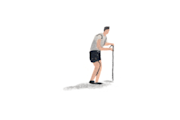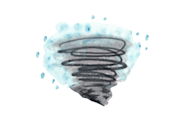Why do cloudy days make me feel sad?
Why is my mood so affected by the weather?
Have you been feeling down on cold, cloudy, or rainy days?
Do you find yourself with less energy and motivation during winter or on gloomy days?
Maybe you noticed you have a harder time completing tasks in wintertime or when it's grey outside?
Seasonal affective disorder (SAD) is a legit concern. Read on to find out
What's seasonal affective disorder (SAD)?
About 30 years ago in the early 1980s Dr. Norman E. Rosenthal and the National Institute of Mental Health coined the diagnosis Seasonal affective disorder (SAD).
Commonly referred to as the “winter blues” or "seasonal depression" Rosenthal’s theory was that a bout of depression he had faced during the northern winter months was due to a lack of natural light, a result of the darker winter season.
Seasonal affective disorder is estimated to affect 10 million Americans, or 3% of the U.S. population, according to Health Matters. SAD affects women four times more than men, and usually begins between the ages of 18 and 30, though children can suffer from it, too.
If you live further north on the globe—particularly in a place that endures longer and darker winters—you may be more susceptible to seasonal affective disorder.
People tend to spend more time at home indoors as the air gets chillier in the late fall and winter. This can be cozy for many (think snuggling up by the fire, reading a book under a warm blanket), but it can also trigger fatigue, depression, and of course, social isolation for those who suffer from SAD.
Symptoms of seasonal affective disorder (SAD)
According to Johns Hopkins Medicine, there are the 12 most common signs and symptoms of seasonal affective disorder experienced during wintertime:
Oversleeping and daytime drowsiness
Loss of interest and pleasure in activities formerly enjoyed
Social withdrawal and increased sensitivity to rejection
Irritability and anxiety
Feelings of guilt and hopelessness
Fatigue or low energy level
Decreased sex drive
Reduced ability to focus or concentrate
Trouble thinking clearly
Increased appetite, especially for sweets and carbohydrates
Weight gain
Physical problems, such as headaches
Symptoms tend to come back and then improve at about the same times every year, Johns Hopkins points out.
Since the warning signs of SAD may be similar to other mental health issues, it's important to speak with your doctor and/or a licensed mental health professional about your symptoms to get an official diagnosis and treatment.
What are the causes of seasonal affective disorder?
SAD is thought to be caused by to both the dwindling natural light during winter months and the body’s circadian rhythms (our natural sleep-wake cycles).
Also, when it’s darker outside, our bodies don’t get as much Vitamin D, which can have an influence on our mood.
Add to that the fact that the body’s instinctive response to darker days is to go into hibernation mode, causing sleep hormones like melatonin to spike, and you have a recipe for a depressive mood.
Treatments for SAD during the winter months include light therapy, talk therapy, vitamin supplements, medication, and general self-care. Find licensed therapists near you with online booking.
Summertime SADness is real too
You may not be aware that the opposite of wintertime seasonal affective disorder—summertime seasonal affective disorder—is a thing, too.
For some people, reverse seasonal affective disorder arrives in the late spring and summer.
Unlike wintertime SAD, which presents with symptoms such as excessive sleep, low energy, and weight gain—summertime SAD inspires the opposite symptoms: insomnia, increased energy, and weight loss.

How does climate anxiety affect mental health?
There are additional impacts climate and weather can have on our mood with regard to to climate change and natural disasters as well.
For years, we’ve seen oppressive heatwaves in the West—some of which started catastrophic wildfires that burned entire towns and filled cities and other locations with smoke for weeks.
Extreme heat has been shown to have adverse effects on mood.
When our bodies overheat, we can become confused, agitated, and even dizzy because our brains are too hot and central nervous systems are on overdrive. These physical symptoms can also contribute to psychological symptoms such as anxiety.
On the East Coast, devastating hurricanes, snow storms, and flash floods can also cause worry, anxiety, stress, and trauma.
Natural disasters and post traumatic stress disorder (PTSD)
Understandably, these unpredictable disasters cause anxiety, stress, trauma, and even PTSD aka post-traumatic stress disorder.
According to the 2015 paper "Mental health effects of climate change" published in the Indian Journal of Occupational and Environmental Medicine, people who experienced a climate related natural disaster "are not only at a higher risk of developing PTSD, but also at a greater risk of developing acute stress reaction and adjustment disorder."
Those who live in parts of the country affected by natural disasters like hurricanes and earthquakes continue experiencing the effects from these disasters long after they’re over. Extreme weather can take its toll on our bodies and minds, even if our property remains untouched.
Even when years have passed since the natural disaster occurred, the symptoms of the trauma can remain in the survivors.
Luckily there are talk therapists who specialize in trauma and PTSD who can help.

What are 3 treatments for seasonal affective disorder?
Whether unpredictable climate events (like hurricanes) or predictable but still distressing seasonal changes (like short windows of sunshine in the winter), it’s a fact that weather can affect our moods. Here are a few basic tips on how to manage the mood swings:
1. Try light therapy, and go outdoors on mild days
Bright Light Therapy (BLT) from high-intensity artificial lights, lamps, or light boxes has been proven effective and is now recognized as a first-line therapeutic treatment.
You can search for SAD lamps online. Don't just buy any old lamp. Optimally, the lamp you choose should have brightness level of at least 10,000 lux of white light. For best results, use the lamp first thing in the morning, and position it about 12 inches from your face.
In addition, if there is a milder day, getting out for a walk or doing some exercise outdoors can lower your stress levels.
2. Talk with a therapist
Finding a licensed therapist to talk with can help you manage and relieve the symptoms of seasonal affective disorder.
In particular, cognitive behavioral therapy (CBT) has been shown to be effective in reducing the recurrence and remission of SAD. See therapists near you experienced in cognitive behavioral therapy.
3. Stick to your sleep schedule and self-care routines
We can’t make ourselves immune to the weather, however getting proper sleep and keeping a self-care routine can reduce the negative impacts of seasonal affective disorder.
READ NEXT: How to Find a Good Therapist Fast
Need to find a therapist near you? Check out the Monarch Directory by SimplePractice to find licensed mental health therapists with availability and online booking.
American Psychiatric Association. (n.d.). Seasonal affective disorder (SAD). Retrieved from https://www.psychiatry.org/patients-families/depression/seasonal-affective-disorder
Blair, H. (2013). Less sunlight means more blues for some. National Alliance on Mental Illness (NAMI). Retrieved from https://www.nami.org/About-NAMI/NAMI-News/2013/Less-Sunlight-Means-More-Blues-for-Some
Melrose S. (2015). Seasonal affective disorder: An overview of assessment and treatment approaches. Depression Research and Treatment. https://www.hindawi.com/journals/drt/2015/178564/
The National Institute of Mental Health. (n.d.). Seasonal Affective Disorder. Retrieved from https://www.nimh.nih.gov/health/topics/seasonal-affective-disorder/index.shtml






